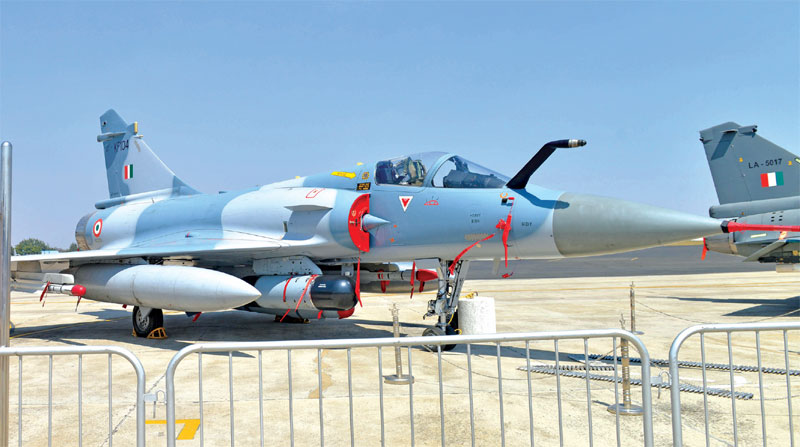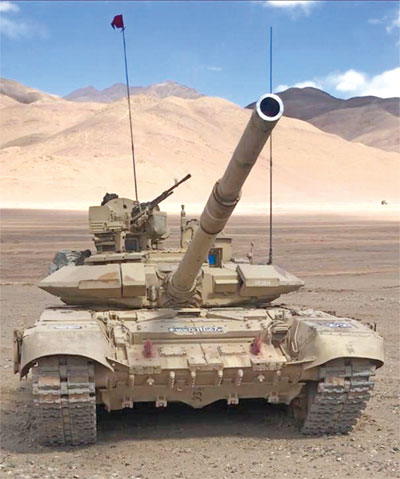Ukraine war underlines importance of true jointness, eschewing inter-force rivalry
 Mandeep Singh
Mandeep Singh
As the Russia-Ukraine war plods along with the air campaign largely being conducted through unmanned deep-strike systems, there is no better time than the present to reflect on the changing nature and methodology of application of air power and how it will affect India. The lessons of the Ukraine air war may take some time to crystallise, but it is important that a look from the ground up be given due import as the application of air power affects surface operations as well.
This is important due to the divergent views held by the army and the air force on the application of air power. Air forces consider themselves as a strategic service and give primacy to the control of the air, with support to surface operations almost as an adjunct. The Indian Air Force (IAF) is no exception as its doctrine notes that “priority must be given to the achievement of control of the air so that the enemy air force’s ability to interfere with own surface force action is blunted.”
Surface force actions are thus given indirect support. One of the roles of the IAF, which is ‘applying direct pressure on the enemy’s power of resistance by attacking his crucial centres of gravity,’ also refers to indirect support. The role of the air force to ‘synergise the combat potential of air power with that of the surface forces’ is the one reference to close air support (CAS) but it is given a lower priority. This has serious implications for the conduct of military operations, especially in the mountains, and it needs a closer look. Before doing so, it will be advisable to try and understand the lessons of recent conflicts, including the Ukraine operations, as they will affect and shape the wars of the future.

Ukraine Lessons
Some initial lessons can be drawn from the Ukraine war, particularly from the conduct of air operations. One of the primary lessons is the need to question the established theories of application of air power, of gaining air supremacy and control of the air. Though the last round has not been fired in Ukraine and it may be premature to draw final lessons, it is apparent that neither side has been able to control the air or gain air superiority and yet has been able to conduct ground operations with varying degrees of success. Gaining control of the air may well be a thing of the past as the two sides settle down to a state of denial of air.
As observed in other recent conflicts also, the means of exploiting the air have proliferated. They are no longer only the manned platforms but include Unmanned Aerial Systems (UAS), cruise and ballistic missiles, hypersonic missiles, deep-strike large calibre rocket and tube artillery. This has been so since decades but in recent times there is an increasing importance being accorded to the employment of unmanned platforms to project air power. The recent Nagorno-Karabakh conflict has demonstrated the potential of using the UAS in support of ground forces. Syrian and Houthi rebels also used the UAS to carry out deep strikes and the same has been observed in Ukraine. This ability of weaker adversaries to exploit the air, even in the absence of a conventical air force, has far reaching consequences on the way air wars will be fought in the future.
The unmanned systems can and will bypass traditional barriers to the use of air thereby denying the adversary the ability to control the air. It is safe to assume that no matter the degree of control, from air supremacy to favourable air situation, the enemy will be able to use the medium of air and retain the ability to interfere in own operations.
As both sides may not be able to control the air space, the contest may degenerate to one of denial, that is to deny the use of the air to the adversary. In this, ground based air defences will play a key role to deny the adversary an unhindered use of the air. In areas where air defences are not credible, the enemy will strive to exploit the air in furtherance of his own ground operations. During the ongoing Ukraine conflict the biggest gains were made by Russia in areas where Ukraine did not have high to medium altitude air defence cover.
The most relevant lesson of the conflict is the importance of jointness. The outcome of Ukrainian military operations has varied considerably based on the extent to which Ukrainian forces have been able to operate jointly. In areas around Kyiv and in the north, the effective close air support the Ukrainian army received, even when it was limited, was reciprocated by sustainment and base-defence support provided to the air force by the ground forces. Russia was successful in areas where the Ukrainian air force had significantly reduced the freedom to manoeuvre and the army was forced to largely fight independently with a subsequent negative effect on the military’s ability to retain ground.
Main Challenges
In our context, jointness is the biggest challenge in order to optimise our military potential. The divergent views of the two services prevent integration and jointness leading to sub-optimal utilisation of resources.

Lack of strategic surveillance and Intelligence: The escalation of the ground situation and the unprecedented PLA build up in the Tibet Autonomous Region duly exposed the lack of strategic surveillance and limitations of our intelligence networks. It led to a knee-jerk reaction before the situation could be stabilised, though to a continuing disadvantage to India. A continued lack of early warning means that our actions may well remain reactive.
China’s A2/AD capability: China has built a highly effective layered air defence system, designed to create a dense, protective and lethal environment for any intruding aircraft. These air defence assets are reportedly well-integrated into a modern informal network providing a highly responsive and effective defensive structure. This will prove to be a significant deterrent to IAF aircraft which seek to infiltrate deep into Chinese territory. The air defence systems are likely to be deployed in the mountainous region of the immediate area of confrontation. These have the potential of limiting our air operations, unless effectively countered and neutralised.
Defining centre of gravity: One of the lessons learnt by the United States in Afghanistan was that the enemy military elements and not the conventional centres of gravity are more appropriate targets in high altitude. Targeting centres of gravity as conventionally defined did not yield the desired results and only when the enemy troops were directly targeted the operations succeeded. What makes for appropriate target(s) in mountains have often been debated between the army and the air force, but seldom have the two agreed to a common end. Rather than looking at the US in Afghanistan and Operation Anaconda, it will be more appropriate to look back at Operation Safed Sagar to better understand this issue.
Safed Sagar
The air campaign began with significant disagreement among the two services. The IAF placed air superiority and the destruction of the enemy’s air power as the first priority whereas the army emphasised the urgent need for close air support. The fact that there was no immediate Pakistani air threat in Kargil justified the army’s prioritisation, but the IAF remained reluctant to start with and came on board after much prodding.

Matters were not helped by the presence of Pakistani ground-based air defence weapons and the loss of three aircraft in the opening days. The IAF suspended attack helicopter operations after the loss of a Mi-17 to a Pakistani shoulder-fired surface to air missile (SAM) and fixed wing aircraft were required to fly far above the target areas to avoid SAMs. The increase in release altitude added to the inaccuracy of aerial-delivered munitions, reducing the effectiveness of close air support to infantry units. It was the use of Mirages armed with laser-guided munitions (LGM) that helped in later stages as the IAF virtually destroyed all of the Pakistani supply lines and played a major role in the battle for Tiger Hill. But it needs to be underscored that despite these gains, the IAF did not provide reliable close air support to the ground troops and its operations did not have the intended impact.
As most of the ordnance dropped by IAF aircraft during the more than 550 strike missions was not precision-guided, the accuracy of munition delivery was severely degraded because of high altitude atmosphere. Army reports claim that of the over 80 close air support missions in June, only 12 projectiles landed near the target with no direct hits. Several close air support missions were reportedly called off early in the campaign because the inaccurate strikes were threatening Indian troops on the ground. One reason for this could be the lack of joint training during peace time for close air support missions. Though the IAF operated an air-ground firing range in Ladakh, it carried out only infrequent training and did not focus on integration with the army. The two services even lacked interoperable equipment. The shortcomings and lessons remain relevant to a large extent even today.
Way Ahead
Going forward, the single most important requirement is to accept the simple fact that only jointness can ensure optimisation of the available resources and deliver the results. In multi domain operations, the main effort will shift between domains as opportunities and threats arise. The need is the ability to employ the most appropriate resource at the opportune time. For example, the commander may direct the air component to support the land component with close air support if it enabled the ground force’s survival or was critical to manoeuvre, regardless of whether close air support is the most efficient use of aircraft.
To achieve such levels of synergy, the first step is to have a joint doctrine to fight in the mountains that is suited to our context after incorporating newer lessons. It should concentrate on joint air-land cooperation with due priority given to the ground forces’ requirements as ultimately it will be the troop positions on the ground that will decide whether the war ends in victory or defeat.
The next step is area familiarisation and joint exercises with the army. The IAF, on its website, admits that “totally unfamiliar surroundings in the Kargil area made target recognition difficult” during Operation Safed Sagar. As mentioned earlier, the IAF carried out infrequent training and typically did not focus on integration with the army. The problem was aggravated by the lack of interoperable equipment with the two services. This needs to be addressed on an urgent basis. After all, if we expect the future fight to be all-domain, then we need to train as we are to fight. It also means greater risk acceptance and increased collaboration within the services.
Operationally, there is a need to establish A2/AD zones using the air force and long range ground-based air defence systems (GBADS) to deny the adversary’s air force the freedom of movement on the battlefield. The Chinese will aim to neutralise the Indian air power with an attrition-based air defence that could include networked air defence systems, electronic warfare and cyber-attacks. The IAF should be well prepared to face high levels of attrition in the first few days and/or counter such Chinese People’s Liberation Army Air Force actions so that it can continue with its support missions. Also, the Army Air Defence needs to be well integrated with the air force’s air defence plan.

One of the major issues that needs to be resolved on a priority is close air support. Due to misplaced priorities in all previous operations, the IAF has failed to plan for successful execution of close air support missions, forcing the army to rely more on the artillery or ask for integral attack helicopters. This issue needs to be resolved. Close air support should be accorded due importance and priority and the army aviation needs to be expanded to include attack helicopters to tide over any hiccups that may come up in the future.
A related issue is the availability and employment of manned platforms for close air support. A critical failing of the IAF while providing close air support is the lack of a low-speed fighter aircraft that is highly manoeuvrable even at high altitudes and has good firepower, including guns for smaller interventions. Though close air support remains a high priority, it is surprising that the IAF has never projected a requirement for such an aircraft. It is time the IAF looks beyond a fifth generation aircraft and focusses on acquiring dedicated ground attack aircraft. Suitably, a transonic fighter with adequate payload and endurance needs to be acquired and using trainer aircraft such as the Hawks and Pilatus as an additional capability may also be worth considering.
Existing structures need to be refined so that they can control and exploit all air assets. In the mountains especially, provisions will have to be made for decentralised, combined arms, small units operating in non-linear and non-contiguous areas of operations. To do so, there should be common communication and data links with due redundancy.
The IAF, like many other air forces, has never given close air support the priority it deserves. It has been reluctant to commit its multi-role aircraft for strike missions against an adversary’s ground forces because of their vulnerability to GBADS. Instead, it has generally employed the older air defence fighters, such as the early model MiG-21s, for close air support whose intrinsic design and inability to carry the appropriate ordnance make them ill-equipped for this type of combat. A related issue is of training for close air support missions that has not being given due
Next War
The next war most likely will be fought along the line of control or the line of actual control. It is not the deep strikes or air combats but the troops on ground and in the mountains that will determine the outcome of the next war. With good training and motivation, a well-equipped army backed by a well laid road and rail infrastructure can win against either adversary, provided the troops are well supported from the air.
It needs to be remembered that air power alone is at best strategically important but is not decisive in a conventional war. It may be able to prevent the adversary from exercising their will, but it is unable to secure contested territories. As Colin Powell said, “air power will be overwhelming in every war, but it’s the infantry man who has to raise the flag of victory.” Once this is understood, the rest will fall into place.

